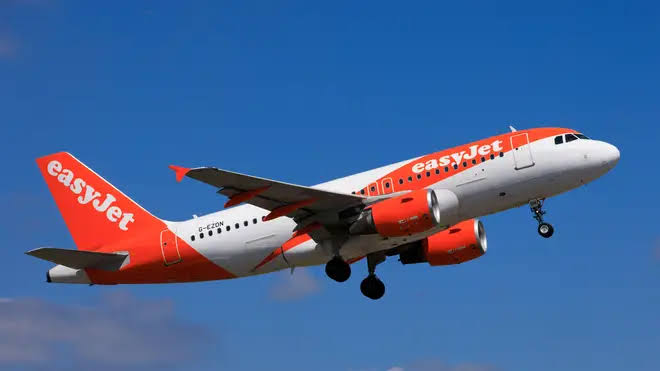
An easyJet flight traveling from Corfu to London Gatwick made an emergency landing in Italy on Monday following severe turbulence that injured two cabin crew members. The incident occurred shortly after the Airbus A320 aircraft, carrying 181 passengers and crew, departed from Corfu Airport at 12:44 pm local time. The unexpected turbulence underscored the unpredictability of aviation weather, highlighting the importance of safety protocols and pilot training.
Approximately 20 minutes into the flight, while the aircraft was cruising at an altitude of 28,000 feet at a speed of 485 mph, the passengers and crew experienced sudden and violent turbulence. At the time, the cabin crew was in the process of preparing and distributing food and beverages. The sudden movement of the aircraft caused two crew members to be thrown violently against the interior walls of the plane.
Their injuries were described as severe enough to require urgent medical attention, prompting the flight’s captain to prioritize an emergency landing. The decision to divert the aircraft to Rome’s Fiumicino Airport ensured that the injured crew could receive immediate care while safeguarding the safety of the remaining passengers and crew onboard.
The turbulence coincided with a period of severe weather across southern Italy, known for unpredictable atmospheric disturbances. On the same day, a Bayesian superyacht near Sicily capsized after being struck by a waterspout, highlighting the intensity of the weather systems affecting the region.
Although the exact cause of the turbulence experienced by the easyJet flight is under investigation, meteorologists have suggested that sudden changes in air pressure or wind speed during these conditions may have played a significant role.
Upon the aircraft’s unscheduled arrival at Rome’s Fiumicino Airport, a team of easyJet staff, medical professionals, and airport personnel were ready to provide assistance. The injured cabin crew members received immediate medical treatment and were later transferred to a hospital for further evaluation and care.
The passengers, although shaken by the incident, were reassured by the efficient response of the airline staff. A replacement crew and a different aircraft were arranged to continue the journey to London Gatwick, ensuring minimal disruption to the passengers’ travel plans.
Meanwhile, the affected Airbus A320 remained at the Rome airport for comprehensive safety inspections. These checks are a standard procedure following incidents involving turbulence to ensure that the aircraft’s systems and structure remain in optimal condition.
In the wake of the incident, easyJet released an official statement acknowledging the turbulence and the subsequent emergency landing. A spokesperson for the airline said:
> “The flight on August 19 experienced turbulence that unfortunately injured two cabin crew members. The captain decided to divert to Rome, where the flight attendants received medical assistance. The safety and well-being of our customers and crew are easyJet’s top priority, and our pilots are trained to manage turbulence.”
This statement emphasized the airline’s commitment to safety and its adherence to industry-standard training for pilots and crew members to handle unforeseen circumstances.
While turbulence is a common occurrence in air travel, the severity of the event left passengers visibly shaken. One passenger described the experience as “terrifying,” recounting how the aircraft jolted suddenly, causing drinks and personal belongings to scatter across the cabin.
Despite the unexpected turbulence and emergency landing, passengers expressed gratitude for the professionalism of the easyJet crew and the swift response of the airline in addressing the situation.
Turbulence remains one of the most challenging aspects of aviation, with incidents varying widely in severity. Airlines are required to train pilots and crew members extensively in managing turbulence-related scenarios. This training includes protocols for securing the cabin, minimizing risks to passengers and crew, and communicating effectively with air traffic control to ensure the safest course of action.
The easyJet incident serves as a reminder of the importance of adhering to these standards. In this case, the crew’s swift actions and the captain’s decision to divert the flight demonstrated the effectiveness of these measures.
This incident highlights the necessity for continuous advancements in aviation safety technology, such as improved weather forecasting systems and turbulence detection tools. Airlines are increasingly investing in technology that allows pilots to predict and avoid turbulence, minimizing risks during flights.
Moreover, passengers can play a role in ensuring their safety during turbulence by following crew instructions, keeping seat belts fastened when seated, and storing belongings securely.
The easyJet turbulence incident is one of several recent occurrences that have drawn attention to the challenges posed by extreme weather in aviation. As climate patterns shift and severe weather events become more frequent, airlines and regulators are under pressure to adapt to these changes.
For easyJet, this event will likely lead to a review of its response protocols and additional measures to prepare for future incidents. However, the airline’s prompt and effective handling of the situation has been widely praised, reinforcing its reputation for prioritizing passenger and crew safety.
The emergency landing of the easyJet flight from Corfu to London Gatwick due to severe turbulence serves as a stark reminder of the unpredictable nature of air travel. Thanks to the quick decision-making of the pilots and crew, a potentially dangerous situation was managed effectively, ensuring the safety and well-being of all aboard.
As the aviation industry continues to evolve, incidents like this underscore the importance of rigorous training, technological advancements, and robust safety protocols to navigate the challenges of modern air travel.